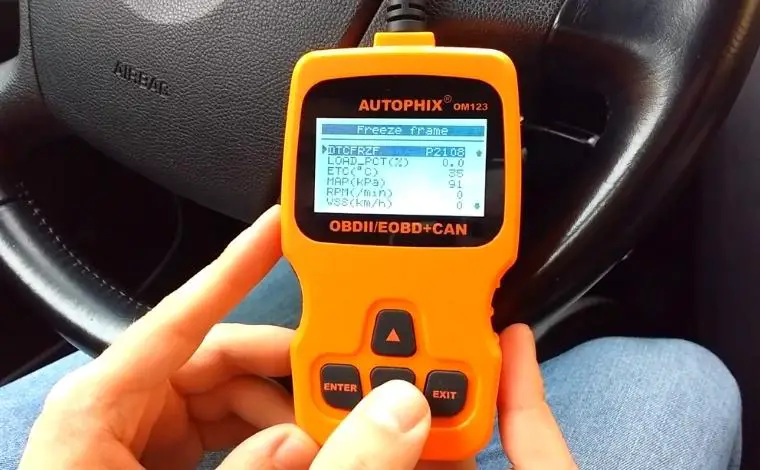Last Updated on May 21, 2025
In today’s automotive world, technology has revolutionized vehicle diagnostics. One of the most valuable tools for both mechanics and car owners is the OBD2 scanner. Among its many features, the term “freeze frame data” stands out as a critical diagnostic component. But what is freeze frame data, and why should every car owner care about it?
Freeze frame data refers to a snapshot of your car’s operating conditions at the exact moment when a Diagnostic Trouble Code (DTC) is triggered. This includes information like engine speed (RPM), coolant temperature, throttle position, fuel trim, and more. Think of it as a paused moment in time, stored by your car’s computer to help identify and resolve the root cause of a problem.
In this article, we’ll break down everything you need to know about freeze frame data — how it works, how to read it, and how it helps in diagnosing and fixing issues efficiently. Whether you’re a professional mechanic or a curious car owner, understanding freeze frame data can save time, money, and frustration.
What is Freeze Frame Data?
If you’ve used an OBD2 scanner before, you’ve probably encountered the term “freeze frame data.” Essentially, it’s a stored record of various sensor readings and vehicle conditions at the time a DTC (Diagnostic Trouble Code) was detected. These values are frozen — hence the name — and provide a detailed picture of what was happening when the issue occurred.

The freeze frame data is captured and stored in your vehicle’s Engine Control Module (ECM) or Powertrain Control Module (PCM). Depending on the make and model of your vehicle, it can include:
- Engine RPM
- Coolant temperature
- Vehicle speed
- Throttle position
- Fuel system status
- Load value
- Short and long-term fuel trim
Once a fault is detected, the vehicle stores this snapshot and turns on the Check Engine Light (MIL). This allows technicians or vehicle owners to retrieve the data and analyze it for diagnosis. However, not all vehicles can store multiple freeze frame records. Older models typically save only one record, which can be overwritten by a new fault if not reviewed in time.
How to Access Freeze Frame Data with an OBD2 Scanner
Reading freeze frame data is a straightforward process if you have a compatible OBD2 scanner. Here’s how you can do it:
- Plug the OBD2 scanner into your car’s diagnostic port (usually under the dashboard).
- Turn on the ignition, but don’t start the engine.
- Follow your scanner’s on-screen instructions to select “Freeze Frame Data.”
- The scanner will display the stored DTCs and a snapshot of the conditions at the time each code was triggered.
Some advanced OBD2 scanners also allow you to save, compare, and analyze historical freeze frame data for long-term diagnostics.
Why Immediate Reading is Crucial
Since many vehicles store only a single freeze frame, it’s important to check the data as soon as the check engine light comes on. If a new issue arises before reviewing the stored data, the system may overwrite the old information — leading to a loss of critical diagnostic insight.
Understanding Freeze Frame Monitors
The OBD2 system uses two types of monitors to store freeze frame data:
- Continuous Monitors: Always running while the vehicle is in use. These include fuel trim and misfire detection. When an issue is found, the system immediately records freeze frame data.
- Non-Continuous Monitors: These activate only during specific driving conditions. They monitor systems like the oxygen sensor, EGR, and evaporative emissions. A problem detected over two consecutive trips will store a DTC along with freeze frame data.
For more information on diagnostic codes, check our car diagnostic codes list.
When is Freeze Frame Data Useful?
The main advantage of freeze frame data is its ability to provide clues about the conditions that led to a fault. This is especially helpful when diagnosing intermittent problems that may not appear during a visual inspection or test drive. For example:
- Coolant temperature: A misfire might occur only when the engine is cold.
- RPM range: A fault might trigger only during high-speed driving.
- Fuel trim values: Might indicate lean or rich conditions at the time of the fault.
The freeze frame data provides a snapshot of these parameters, giving you an edge in pinpointing the root cause quickly and effectively. By understanding what was happening during the fault, you can make more informed repair decisions, saving time and preventing unnecessary part replacements.
Limitations of Freeze Frame Data
While freeze frame data is incredibly useful, it’s not foolproof. Here are some limitations:
- Older vehicles may store only one frame of data.
- Some scanners might not support full data access.
- The data can be overwritten if not retrieved quickly.
It’s recommended to use a high-quality scanner to access complete freeze frame data and ensure no critical information is lost during troubleshooting.
Conclusion
So, what is freeze frame data in an OBD2 system? It’s a diagnostic goldmine — a snapshot of critical sensor readings taken at the moment a problem occurred. For mechanics and DIY enthusiasts, this information is invaluable in identifying and resolving problems early. Whether you’re dealing with engine misfires, fuel system issues, or sensor malfunctions, freeze frame data gives you a better understanding of the problem’s conditions.
Always remember to check and record freeze frame data quickly. Delays can lead to overwritten data and missed diagnosis opportunities. If you’re serious about maintaining your car, investing in a good OBD2 scanner is essential.
FAQs About Freeze Frame Data
Can the OBD2 scanner store multiple freeze frame data?
It depends on your vehicle model. Most older vehicles can only store one freeze frame snapshot at a time. Newer vehicles with advanced ECUs may store multiple frames, but it’s still best practice to check the data immediately after a fault is detected.
Can the check engine light turn on without freeze frame data?
Yes, it can. In rare cases, the check engine light may appear without storing freeze frame data — especially if the fault was intermittent and corrected during the next drive cycle. Some errors are cleared automatically after a warm-up cycle.
How can I clear freeze frame data?
To clear freeze frame data, reset the ECU using your OBD2 scanner. This will also clear the Check Engine Light (MIL) and stored DTCs. However, if the issue hasn’t been fixed, the same codes and data will reappear after the next drive cycle.
Will freeze frame data be stored without the MIL turning on?
In some situations, yes. For example, if the vehicle detects a minor issue and automatically corrects it, it may still store a DTC and freeze frame without turning on the warning light. However, this is not common and varies by vehicle system behavior.
Related Resources
- How to Use an OBD2 Scanner
- Best OBD2 Scanners for 2025
- Why Your Check Engine Light Is On
- Complete Diagnostic Codes List
Kevin Nicholas is an automotive technician who is a genius at software and hardware-related issues. He manually tested more than a hundred OBD scanners and gave his honest opinion on whether the device was worth the money or not. His in-depth OBD review articles help people choose the right product, whether it is a European, American, or Asian vehicle. He completed his Automotive Specialized Training Course at Universal Technical Institute and has more than 15 years of experience in the field.
